Sometimes, first time is the charm.
For Rebecca McLachlan, she knew what she wanted to do after studying wildlife management and conservation at Humboldt State University in California. As it turned out, keeping her eyes open for opportunity panned out sooner rather than later.

“This is my dream job,” said the hoofstock animal care specialist at Fossil Rim Wildlife Center. “I’m so excited to be here. I’ve always loved animals, and I’m so passionate about the conservation work being accomplished at Fossil Rim.
“Working with hoofstock has been my goal, which comes as little surprise since I’ve worked with horses for about 10 years. I took an environmental science class in high school and developed an interest in conservation and how I could make a difference.”
A native of Santa Clara, California, McLachlan began her career at Fossil Rim Feb. 28, but it was not her first time on the property.
“I was the black rhino intern here in the summer of 2013,” she said. “I was keeping an eye on a position becoming available here ever since then.”
Fossil Rim was one of her four internships, which most recently included White Oak Conservation in Florida. Both institutions are members of the Conservation Centers for Species Survival (C2S2).
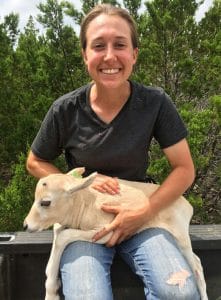
“I really like the C2S2 facilities,” she said. “They have large pastures and natural herd sizes; I like working with species in this setting where they really thrive. I was still at White Oak when I applied for this job.”
When asked to define her role on the Fossil Rim hoofstock staff, McLachlan is not being stubborn when she finds it difficult to pinpoint.
“I don’t have a very defined role, and that’s actually a reason I was really excited about this job,” she said. “During the interview, I was told they were looking for a swing keeper in hoofstock. Justin (Smith) is the primary person for rhinos, Molly (Shea) is the primary for giraffes and Michael (Birt) primarily works the pens. There was someone already covering all of the pastures, so I was needed to fill in.
“When Molly goes to work with Attwater’s prairie chickens in the summer, I mostly cover giraffes. I cover Front Pasture, Buffer Pasture and pens for Michael on his weekends. I’m still training on rhinos, but I am able to cover for Justin there.
“I love rhinos, giraffes, equids, antelope and the opportunity to be a part of all of them. I’m like everybody’s helper, and it feels good when they ask me for a second opinion on something every now and then.”

The animal care staff never has a shortage of things to do, and McLachlan explained what is expected of her.
“I always start the day helping feed and check animals,” she said. “We have managed herds, so we know how many individuals we have. We count them every day, and if somebody is missing, we want to go find them in case they are injured or having a baby.
“If an animal is injured, we will call the vets so they can come take a look. I also have to be ready for something random, such as a guest reporting something unusual they’ve seen.”
Animal care often works in tandem with the animal health department.
“When we have a major event like a rhino immobilization, it’s all hands on deck,” McLachlan said. “With such a big animal, there are a lot of things to monitor like breathing, fluids and simply watching for signs the animal may be waking up. On these days, we come in early to feed the other animals and get back in time to help make sure the procedure goes smoothly.
“Generally, the larger the animal, the more people required to help with a procedure. If we are doing multiple immobilizations in a day, you have to be prepared to possibly perform a different duty each time.”
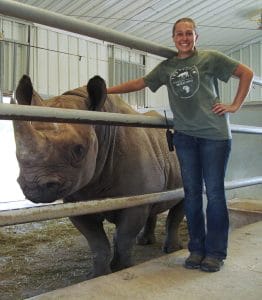
Even though she completed four internships, McLachlan still had a learning curve when she joined the Fossil Rim staff.
“It was a lot to process when I started here and a big step up,” she said. “Interns do a lot at all the facilities I went to and the staff members were very inclusive, but as a staff member there is quite a bit more responsibility, which was new and exciting. You are trusted with a lot more. I’m in charge of those animals in a particular pasture that day, so I need to be aware of how they are all doing and if anyone is missing.
“I took a lot of notes in the beginning, and I still do on really busy days, but sometimes I’ll just keep it in my head. Every animal has its own record, and we fill out a daily report for events of the day so we can keep track of everything that goes on.”
Speaking of a given animal, familiarizing one’s self with individuals is expected of the staff.
“Getting all the herd numbers down for different species, and then learning the individual animals was a challenge,” McLachlan said. “For example, I was training with Molly and, when we’re driving through the Main Pasture, she can just pick out addax based on horns and not using ear tag numbers.
“I couldn’t believe she was doing that with dozens and dozens of addax to know, but over time it starts to become second nature. I learned how much each pasture gets fed, and I started to learn individual animals once I gained a good foundation.”

With so much to understand, McLachlan found it reassuring to have support constantly offered from her coworkers.
“We usually work individually in the mornings in different pastures,” she said. “If I am feeding a particular pasture when we are all here, it is usually Main Pasture. The hoofstock staff has been really helpful. I started off training with Molly, and every day in the truck she’d quiz me on the same things.
“She’d ask ‘how many gemsbok are there’ or ‘who is that addax over there?’ She’s been great.
“Michael takes opportunities to teach me stuff in the pens, such as practicing shifting animals from pen to pen while keeping them calm and safe. Justin tells me to always ask questions and not to hesitate to call for help.”
McLachlan said that although deer are not counted like the antelope species, animal care staff still works to ensure all the species stay healthy.
“We don’t keep count of deer, other than European red deer, but if we see one of them limping, for example, we check it out,” she said. “Even though some animals here are rarer than others, I treat them all the same; I love them all. Deer are so cool, and I work to make sure all the animals here are cared for and have good lives.”
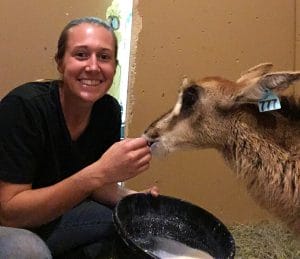
Guests adore seeing baby animals, and so do staff members, it seems.
“I really enjoy the neonate exams,” McLachlan said. “After a calf is 24 hours old and has bonded with its mother, we want to check its health status and give it an ear tag. It is exciting to go find the mother and try to get her to lead you to the calf, as well as being able to get it without upsetting her. You watch pregnant females that are calving soon very closely.”
Her enthusiasm is evident, and McLachlan is passionate in her support of Fossil Rim’s efforts for threatened and endangered species.
“We are so involved with other conservation groups,” she said. “It is so exciting to think about how we contributed scimitar-horned oryx to the World Herd for reintroduction into the wild in Africa; that’s so cool to me. It is so rewarding and encouraging to see endangered species thriving, breeding and keeping some wild characteristics – it is so important. For example, when an addax gives birth here, it can wander 200 yards away from the road and keep its calf hidden amongst the trees until it is ready to bring it out.
“I find the herd setting so valuable: the interactions between the breeding bull, the matriarch, yearlings, calves and the hierarchy within the herd is fascinating. You see it between species as well, such as in the Main Pasture, for example. Sable always get food pellets first, while waterbuck always get pellets last.”
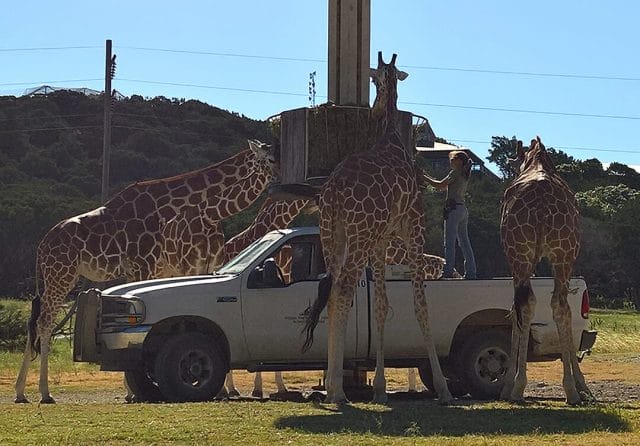
While the grass is always greener in the other pasture for many young professionals, McLachlan is perfectly happy with her conservation situation.
“This is my first actual job in this field, and it’s what I want to do,” she said. “I am excited to be using my skills to help conservation. Some days I still pinch myself about working here.”
With such exuberance, she certainly makes a convincing case to a potential first-time Fossil Rim visitor.
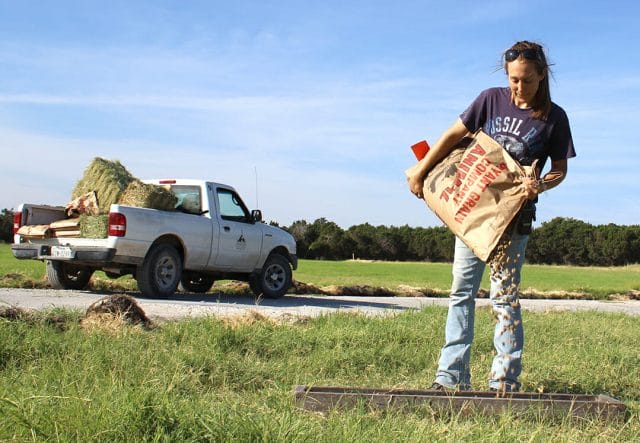
“It’s magical,” she said. “It’s very unique to have animals in a setting with so much space. For example, sometimes we have a hard time finding our herd of seven giraffes, as they may be in the trees or in a valley. To see them browsing and moving in a natural setting – it feels like I’m watching them in Africa.”
-Tye Chandler, Marketing Associate
November 15, 2016

What a wonderful story about our sweet Cousin Becca! Being passionate about conservation is who she is. We are so proud of her and are looking forward to visiting Fossil Rim soon!
I’m glad you enjoyed it. She is an awesome person, very glad I featured her.